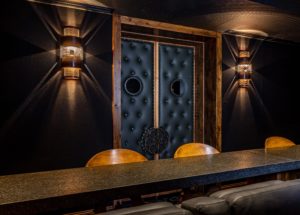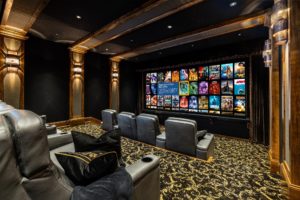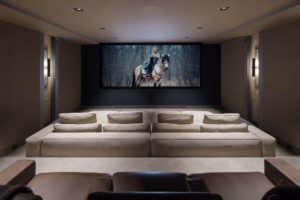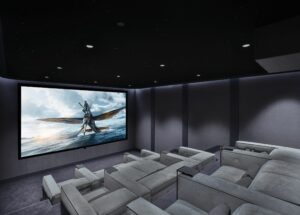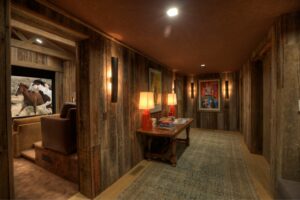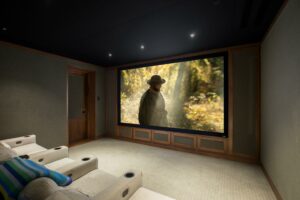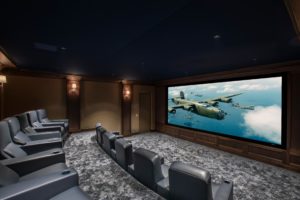The Buffalo Run Cinema
A new chapter, home, and an amazing locale. Buffalo, elk, wide open space and miles from everywhere. A long way from the past and from where they had been, but it is where they will build their forever home. And what a home. “One of a kind for hundreds of miles around” the owner claims. Crafted with exquisite attention to detail and filled with all those things the couple has grown to love over the years. A private cinema is one such item.

This latest chapter starts with the builder. In such a community where the population is as small as the countryside is wide, it is vital that relationships are strong. In this case, Aaron Taylor Construction brings a reputation of earned respect and brought James Rothwell RA, NCARB onboard when a change needed to be made with the previous project architect. The owner’s interests would be well served by a design and build team that already had a solid working relationship. As James affirms, “I had a great track record with Aaron on multiple previous projects.” The owner took comfort in having a “general contractor coordinate everything in conjunction with the architect,” with one notable exception. The owner continues, “that applied to the rest of the house except [the theater]. Neither the architect nor the contractor had ever built one of this scale.
Another trusted partner referred by Taylor is Dan Berghoff, owner of Axxis Audio. Dan, who has worked with both Taylor and Rothwell, brought a rare mix of wisdom and insight, realizing what he didn’t know and advising the team that their client would benefit from some specialized expertise. Advice that proved to be spot on from the client’s perspective, who, referring to lessons previously learned stated, “I knew enough about it [private cinema] that I knew what I wanted.”
The First Chapter and the Mid 90’s
Lessons first learned almost 30 years ago in another new home. This time, a purchase, the home included a blank canvas for the new home theater enthusiast. “I knew I wanted to build a theater room and I was looking for a place to do it in.” says the owner recalling an unused room adjacent to the attic “making it ideal for the retrofit work.” He noted, “I told my wife, this is it! and she said “No, it’s not. We’ll never use it.” The owner’s response, “we’ll see!”
The ’90s offered so much less than today. Surround sound formats became digital with the first Dolby Digital laserdisc in 1995, finally upgrading from ProLogic to a 5.1 channel format. The first Dolby Digital DVD was released in 1997. On the image side, bulky low light and low-resolution CRT projectors were the only game in town. Still, enthusiasm was high, and the owner was not going to be denied! He states, “I set about proceeding with the project and worked with a consultant.”
At the time acoustical and audio engineering capabilities for home theaters were limited however the consultant analyzed the room and engineered the electronics placing the loudspeakers where they needed to be. He also balanced the sound, performing the rudimentary calibration that was available at the time using a testing microphone and analyzer, and also performing the painstaking calibration of the CRT projector. All in all, a fine result at the time.
The couple had the home, with its private theater for three or four years. The owner recalls they “really used that theater” saying it was “awesome” and “a key feature when we sold the house.” The owner reports, “We spent every Friday night [in their theater], so we did use it a lot more than my wife expected,” adding, “she came to realize that the quality of the audio and the video and the ability to hit the pause button was better than going to a public theater. She was willing to wait the six months until the DVD came out to see new issue movies, she understood and became a convert.”
In fact, she coined the phrase that illustrates just how important their private cinema had become, “Chair time.” As the owner tells it, “We put these awesome chairs in that were super comfortable. I was working in a really tough job then and was doing a lot of international travel. I would come home, worn out. And my wife would say, you look like you need some chair time.” He laughs, “and I said, yes, I do.” Laughing again, “I knew we were going upstairs to the theater room.”
Planning the New Private Cinema
Dan had the insight to go looking for what the client wanted. “I had been told the scope, but once I started talking to the client, I realized that his vision was much more.” Dan adds, “he really knew what he wanted from an acoustical standpoint.” Dan interviewed theater design companies that industry reps and project partners recommended. He admits, “we kept running into dead ends when they fell short of what he wanted.” He had better luck with the audio system.
“He [the owner] and I flew out to Southern California to the PRO Audio Technology Experience Center, and he fell in love with the sound!” reports Dan. PRO has curated and delivers what founder L. Paul Hales describes it as “A formal program where we’re flying people in for a visceral and emotional demonstration that words alone cannot convey.” (Editors note: See Cinema Intelligence.) Paul recalls, “He flew himself and Dan out in his little jet!” After meeting the owner Paul also recognized his expectations of performance in his new cinema. “He had heard other speakers and knew it wasn’t satisfying him. With his engineering background, his personality is to really do things right. He wanted a more fully engineered system and design for the acoustics.” Paul recommended Paradise Theater to provide that room design to bring the best out of that system.
Chapter 2, The early 2000’s
Meanwhile, as the project timeline moves forward and the home’s architectural design progresses, the owners recalled another chapter in their private cinema journey. Another theater where more was revealed. The owners had sold their home with its theater and lived abroad for several years. When it was time to return to the US and find a new home, they found one that already had a theater, but it was merely a jumping off point for the owner who had become something of a cinema connoisseur with his first home theater experience. “There was a standard seven channel speaker system and a screen that was too small. The electronics were older and it sounded awful, but I knew I would gut it,” the owner recalls.
The couple proceeded to do just that and applied what they had learned to this new theater project. “I wanted a screen that would go wall to wall!” He goes on to say, “we replaced all the speakers and electronics.” They had also developed some ideas of their own. “Kind of a signature thing that we did by accident in the first theater,” he describes, saying, “we liked to put in two rows of seats that have a vertical step. Behind the second row we put in a bar. What we discovered with the first theater is my wife and I like to go up there and watch movies, but we also used it for entertaining and sports events.”
It seems each chapter in their cinema story had revealed new insights. “My screen was so big, and we were so close that I experienced, for the first time, this issue from the front row. I could see the little window shades,” the owner recalls, continuing to say, “I think it was right after HD had come out. Everybody thought it was amazing. We’d regard it as terrible now.” Lessons were learned about theater sound as well. “When you’re a rookie at this, you focus more on the video side, but over time you get more and more focused on the sound side,” he explains. “I’ve always been a fan of accuracy, but also of the subside and I always like to have some control over that bass volume so I can get it the way I want it.”
By the time the second theater was done technology included 7.1 digital surround, Bluray and HD video, all vast improvements but there were more lessons yet to be learned. “We changed out all the electronics and speakers, but we kept the room noise,” the owner concedes. “We did everything we could to eliminate the room resonances that caused the buzzing and noises. That really bothered me. I realized then we would have had to design it from the ground up to avoid that.”
Building the Team
“This is my third [private cinema]” the owner tells Ryan Brown, President of Paradise Theater, “but it’s my first one that I’m building from scratch.” Ryan knew the owner had spoken with some theater design companies and that he was looking for something extraordinary. “I explained our process,” says Ryan. “We call it Excellence, Always, and it is a systematic design and engineering process we have developed to address every aspect of a private cinema and deliver the very best possible result, every time.” The owner recalls, “I immediately knew, okay, this is what I’ve been looking for.” The project had continued to progress however, while the search for solutions transpired as the owner allows, “it took us a while. Unfortunately, [Paradise Theater] got involved after some of the structural decisions in the room had been made.” He continues to say, “even though it was a new construction blank canvas, we didn’t get all the benefits of a blank canvas.” Brown speaks to that, explaining, “Excellence Always means, no matter what the circumstances are, we provide the best results and performance possible.”
A big part of a project’s circumstances is team chemistry. Brown knows from experience how important it is to create a positive collaborative environment. “Our ultimate goal is unparalleled service to our client. Adversarial relationships won’t achieve that.” Ryan explains. “Other team members had put in quite a bit of work before we were brought on board. Our process is to evaluate everything and report back to the team, objectively. If changes are indicated, we explain why in a constructive manner and help the client and the team make the right choices from an informed position.” After the first pass of functional concepting was completed, several decisions were on the table.
The most important of those was the configuration of the room’s foundation and resulting seating positions and specification of the screen size and position. “The location of the primary seating position is pivotal, impacting and impacted by several, often competing, factors,” explains Ryan. “Acoustic, audio, video, ergonomic, aesthetic and structural considerations which all must be analyzed and determined. Our team at Paradise employs an iterative process that addresses all such considerations holistically. The process includes the development of an accurate and highly detailed three-dimensional CAD model and predictive acoustical modeling of the room. This “functional concept” step in the process results in some alternatives that offer the best possible solutions.” These were developed by the Paradise team and then presented to the client and project team.
The final, “informed decision” was made collaboratively. “It is a team approach with the clients’ interests at the forefront!” reports Ryan. The owner concurs, “we put certain constraints on [Paradise Theater] because of where we were, and you guys did the very best that could be done with what we had. That’s exactly what happened.”
In addition to the obvious private cinema questions relating to seating and screen, less obvious but equally important questions were resolved. Lessons learned in past theaters brought the subject of room noise to the forefront. The owner’s previous experiences had made them aware. “So many who have home theaters built, overlook or are misinformed about what it takes to create a distraction free environment.” Explains Ryan, going on to relate, “We often hear that they don’t want to pay for acoustic isolation.
The term isolation seems to create some resistance. That’s why we refer to our work in this area using the terms quiet room and distraction free environment.” A distinction that is relevant for this owner because their interest is not in containing the sound of the cinema but in eliminating distracting noise for those enjoying the show! The engineering team at Paradise made sure that the objective was achieved. “We ran our calculations on all proposed acoustical construction and mechanical systems. Those calculations showed the proposed designs would result in a background noise level (BNL) that was within our Excellence Always criteria,” reports Keshav Nelavai, Lead Acoustical Engineer at Paradise Theater.
With Team Paradise fully up to speed and collaborating with the rest of the team, theater design development and construction could proceed as a coordinated effort. Drawings for the theater chassis, including all changes resulting from engineering, were produced by Team Paradise and distributed to the project contractors. “Our documentation sets are developed with the intent that the project’s general contractor will be building out the room. Taylor Construction was more than qualified and was great to work with,” states Ryan. Chris Lindell, Project Manager for Taylor Construction adds, “once Paradise gave us the prints, we were able to just follow up and build it as they showed it.”
As a musician and recording engineer himself, Chris understands the importance of acoustical details adding, “we ordered all the material, isolators and items like that, as specified in the prints, that’s important. We’re going to use the items [Paradise] expects.” There was one compromise however that, ultimately, was accepted. Paradise however made certain that everyone, most importantly, the owner understood the impact of that compromise and what was being agreed to. Ryan explains, “the double door was very important to the architect and owner’s aesthetic vision. Any door is the weakest link in a quiet room design but a double door is always a bigger compromise.” Ryan continues, “our responsibility is to communicate what such compromises will mean so that the client is truly making an informed decision. We will be agreeable if that understanding is clear.” Dan points out, “Paradise made everyone aware that the door selected would not perform to Paradise Theater’s criteria and would result in some noise. I function like that too. It is better to be upfront about issues that will be present at the end. That way, it was not a surprise.”
Chassis construction was underway and, simultaneously design development and collaboration began in earnest. Paradise Theater Interior Designer, Sarah Reed, relates how that collaboration was initiated. “We had a discussion with [the architect] on how we needed to proceed. The way that worked was that we did modify the design of elements that needed to change, explaining to him the performance driven rationale. Having that communication, he was very understanding.” The engineering team was then able to finalize predictive acoustical modeling and acoustical treatment plans so that the aesthetics team was able to proceed with confidence. James recalls, “in regard to the design theme, detailing and finishes, which is kind of my driver, I don’t think there were any surprises there. They had some minor layout modifications, to work with speaker, acoustic and lighting locations which ended up coordinating very well with the design.” Sarah adds, “James provided lighting specifications that were being used throughout the home and an initial layout for the cinema. We used that as a starting point to create a lighting design for private cinema with scenes and zoning in mind.
We also worked together to plan air supply and return registers that would quietly ventilate the room unobtrusively. That was not as easy as it can sometimes be but after several iterations, it came out very nicely!” Private cinema interiors can be deceptively complex design challenges. Today’s private cinemas with as many as 34 or more loudspeakers, acoustical devices, lighting and more, leave little wiggle room for interior details. Often the solution is to surrender, after all, the lights are low anyway! But when the design team embraces the challenge and collaborates to create a triumph of form-fulfilling function the result is remarkable and amplifies the private cinema experience with dramatic anticipation. Entering such a stunning environment whets the appetite for what’s in store when the lights go dim and the cinematic journey begins!
Of course, designing and engineering are works of the imagination. It is upon the rest of the project team to bring those visions to fruition. Having completed the finest custom homes for over 25 years and building a reputation for maintaining the finest standards of craftsmanship, Chris and the Aaron Taylor Construction team set about to do just that. These qualifications become even more impressive when combined with the wisdom to ask for help when needed. The complexity and demanding standards of excellence would not pose a problem but the addition of high-performance audio and very high performance expectations added a new challenge.
Chris and his team recognized when they required support and reached out whenever it was needed. “Probably the biggest challenge for us was just understanding the details, having never built a [private cinema]. I would take a lot of pictures, call Ryan or Kyle [Kyle Brown, VP Operations and Quality Assurance] and say, are we doing this right?” Kyle is glad Chris called, saying, “it’s never a problem to answer a question but it is never much fun to correct a mistake, or worse, discover one that can’t be corrected.” Chris’ strict adherence to verification paid dividends when Kyle was able to write in his QA report, “Great job everyone; I’m very excited about the progress and can’t wait to see/hear the finished room!”
Dan recalls one of the high points for him, “I remember at one point seeing it all come together, just before the screen and wall coverings went up. Just seeing everything that went into the room.” Before heading to the finish line the construction team has successfully fabricated layer upon layer of carefully coordinated construction and systems. It has had to be meticulously assembled as engineered to avoid vibrations and rattles that could surface when the powerful sound system is activated. Precision is required as well. Dave Stern, owner of Acoustic Treatment Technologies talks about the behind the surface care that is necessary. “Our scope was limited to installation of the acoustical fabric system.
That’s the track hardware that the fabric attaches to and the fabric itself that covers most of the walls and ceilings. When we build out the entire room ourselves, we know it will be right because we are aware of how tight the tolerances need to be.” Dave goes on to explain how a variance of as small as 1/8” can result in a visible defect. This extends from the rough framing, through the isolation layer to the interior light framing and millwork. Dave is happy to report, “I was in communication with the project manager who was key. He and their finish carpenter, followed the designs and our recommendations to a T. When I walked onto the project it was spot on!”
As important as the functional and behind the scenes elements are to the aesthetic and performance quality of the cinema, attention to the little things adds up to a truly remarkable cinema interior. From the owner flying out to Southern California to test drive theater seating, the careful selection and acoustical testing of wall and column fabrics, coordination with millwork finishes, authentic film reel door pulls and real buffalo nickel wall upholstery brads, the phrase design is in the details is well said for this private cinema! There was however one vital step left in the journey.
A private cinema, particularly one as well equipped and engineered as this, is analogous to a high-performance automobile or even a finely crafted musical instrument. To realize the potential designed into it, precise tuning is required. Paradise Theater and PRO Audio Technology created the acoustic system, the room and the loudspeakers respectively, so it is fitting they collaborate on tuning it. Keshav and Dan spent a day testing, time aligning and listening. No small task in a system with 22 loudspeakers and 6 subwoofers powered by 57 channels of amplification! Keshav relates, “when we got a chance to listen, the experience was transportive, impactful and transparent. Not just the subs either, the entire immersive system was powerful at all frequencies.”
Transparency is an evasive and vital quality in immersive audio systems. With so many loudspeakers all around it is common to localize one or more. A phenomenon that interrupts the immersive suspension of disbelief. Keshav relates part of this success to one of Paradise Theater’s core values, called Ever Better, explaining “It was good to see the results from the latest developments to our engineering process. From engineering loudspeaker locations to acoustical modeling and treatment specification, the process resulted in the most realistic, immersive and transparent experience I have ever heard.” Keshav also gives a lot of credit to the loudspeakers saying, “They performed effortlessly at every frequency and throughout the dynamic range. The headroom that makes that possible affects the experience of transparency of whatever you are listening to, from the most delicate passage of music to the most visceral and percussive action scene. The system just disappears!”
Paul and Keshav spent the second day taking the room from great to extraordinary. Paul describes it as “a refined, big scale theater sound, but also super detailed. An experience that’s right up there with the top rooms that you can find anywhere.” Paul goes on to say, “as a brand, we always leave every room sounding the best it possibly can. We want the client to be tickled with it.”
Dan was a part of this chapter of the story from the beginning. He may have been the first to truly hear what the owner meant when he said he wanted his cinema to be something special saying “once I started talking to him [the owner] I realized that the scope was much more.” His insight led him to some new partners and a team that worked together to deliver that dream. “Paradise Theater brought a team approach that was effective, and the theater was a success.” Reports Dan, saying, “the acoustics are great, the room sounds phenomenal, the video is amazing, the customer turns it on, and it works every single time!” This cinema story has given Dan new insights that he shares with others saying, “Their private cinema is their ultimate electronic amenity. They use it, love it and fully enjoy it. It is a phenomenal addition to their lives and is definitely worth the effort and investment.”
The owners, who couldn’t agree more, have this to say, “This was our third and best theater room. We are very pleased with the result and the room is highly utilized by us. We typically use the room three to four nights per week, not including when we have guests over. We are fortunate to have a room like this available to us for daily use as it has become one of the more enjoyable ways for us to spend our leisure time.”
